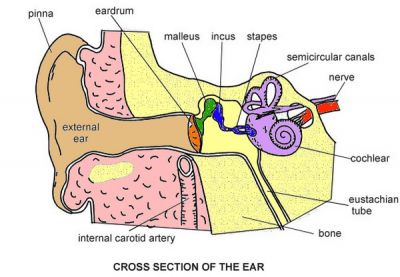A cochlear dead zone is a rare type of hearing loss that results in a severe hearing loss in a narrow range of sound, because the corresponding sensory cells have been destroyed.
The ear can be a delicate mechanism. Even though the most fragile parts are tucked deep inside your skull, your ear is still open to the outside world and therefore susceptible to many forms of damage.
All along your cochlea, the spiral-shaped part of your inner ear, is the basilar membrane, which vibrates as sound waves hit the ear canal. On top of this membrane sit microscopic hair sensors that vibrate along with the membrane, in turn communicating those vibrations to the brain.
Many forms of hearing loss are caused by damage to these hair sensors. In rare cases, patients may have what is called a cochlear dead zone, in which certain areas of these hair sensors or other neurons have been wiped out completely, and the patient is unable to understand sounds at a certain pitch where those hair sensors have been erased. For these patients, certain tones will often sound distorted or unintelligible.
What causes a cochlear dead zone?

The basilar membrane winds through the cochlea in the shape of a snail shell, receiving sounds at lowest pitches in the center of the spiral, or apex, and highest pitches at the outer end, or base. In a cochlear dead zone, the hair sensors or neurons will be missing from a certain range along this membrane, and the patient will be unable to hear sounds at the corresponding frequencies.
The most common dead regions occur at the basal portion of the membrane where high-frequency noises are intercepted. Brian C.J. Moore, a leading expert on cochlear dead zones, says these are most often caused by exposure to intense sounds, like explosions or gunshots.
Less common are dead regions at the apical end of the cochlea, which perceives low-frequency sounds. This can be caused by late-stage Meniere’s disease. Dead regions can occur anywhere along the membrane, however, and can be caused by a variety of factors, including genetics, illnesses or exposure to toxic chemicals.
How do I know if I have a cochlear dead zone?
Research is still being done on cochlear dead regions, so we don’t know how common they are. But audiologists are able to diagnose dead regions approximately 95 percent of the time through a threshold-equalizing noise (TEN) test, which is similar to a pure-tone audiometry test. It only takes a few moments, and involves doctors trying a series of sounds at different pitches and intensities to gauge your hearing response.
Since the majority of dead regions affect higher pitches, one symptom of cochlear dead regions is hearing loss that increases rapidly with the rising frequency of a sound. Another symptom is that certain tones will sound distorted when the rest of your hearing is fine. These symptoms do not always mean the patient has a cochlear dead zone, however. Researchers are still trying to understand these hearing holes.
Hearing aids and cochlear dead zones
Tests are still inconclusive on whether hearing aids are helpful to those patients with cochlear dead zones. In some cases of a high-frequency dead zone, hearing aids can improve the symptoms, but not always. A discussion with your audiologist can provide more insight into the condition and possible resolutions.
If you think you are suffering from hearing loss, the best way to find the right solution is to contact a hearing health provider in your area.
